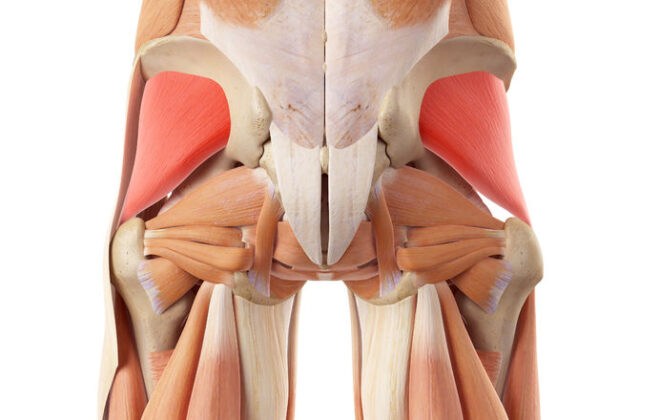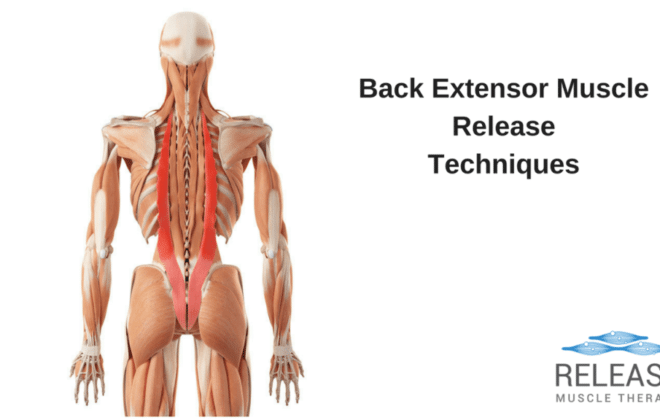Low Back Trigger Points – Pain Relief Techniques
If you’ve ever felt a sharp ache or a dull throb in your lower back, you’re not alone. Low back pain can be more than just an annoyance; it often hinders our day-to-day activities and overall quality of life.
But what if the culprit is tiny trigger points hidden within your muscles? These little knots may seem small but have the power to cause significant discomfort.
One intriguing fact about low back trigger points is that they frequently stem from common habits like poor posture—think slouched shoulders or excessive lumbar curvature. By focusing on these pressure points, we can address some of the root causes of back pain.
This article will guide you through understanding and identifying these pesky areas, along with providing effective techniques for relief so you can get back to living comfortably.
Ready to say goodbye to that nagging pain? Let’s dive in!
Key Takeaways
- Trigger points in the lower back can cause sharp or dull pain and may refer discomfort to other areas of the body.
- Effective treatments include neuromuscular massage therapy, targeted stretching, and exercises specifically designed to relieve pressure from these trigger points.
- It’s important to identify key muscles such as the quadratus lumborum, spinal extensors, and multifidus that are often affected by trigger points.
- Certain conditions like blood disorders, recent fractures or surgery, skin infections, severe osteoporosis, advanced diabetes, acute flare-ups of low back conditions, or tumors require caution or prevent individuals from undergoing trigger point therapy.
- Regular incorporation of therapies and exercises targeting lower back trigger points can greatly improve one’s quality of life by reducing pain and increasing mobility.
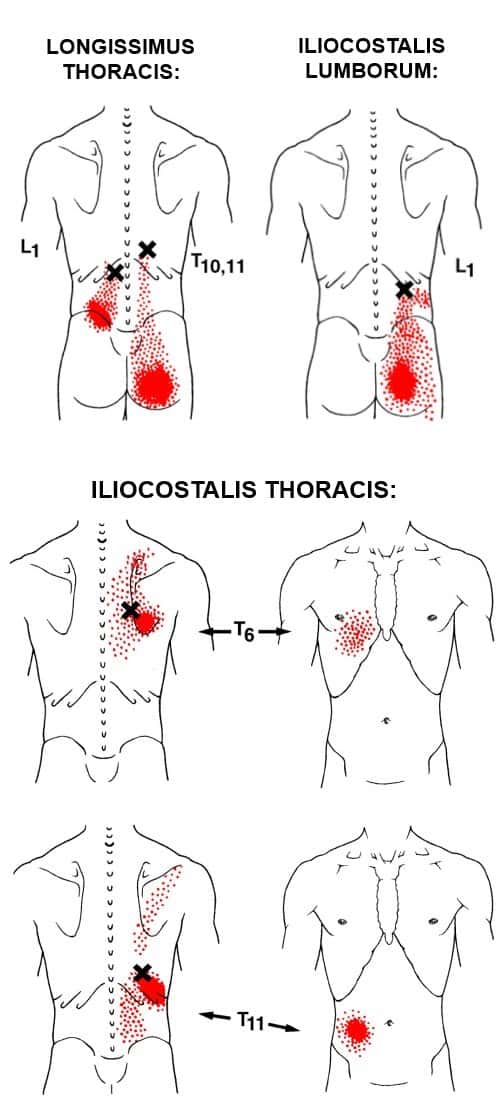
Understanding Trigger Points and Their Impact on Low Back Pain
Trigger points play a significant role in causing low back pain, and they often develop from daily habits like poor posture. These are tight knots within your muscles that can cause pain right at their location or refer it to other areas of your body.
You might find yourself experiencing discomfort not just in the lower back but possibly also in the hip region because these trigger points have a knack for sending pain signals to different spots, making it tricky to pinpoint the source without proper knowledge.
Effective treatment of low back trigger points involves therapies such as manual pressure, which helps release these stubborn knots. Massage therapists use targeted pressure to ease the muscle tension and provide relief from myofascial pain that stems from these trigger points.
By understanding how they affect your body, you can seek out specific treatments like ischemic compression or self-massage techniques designed to alleviate lower back issues directly related to myofascial trigger points.
Moving on, let’s dive into identifying key lower back muscles affected by trigger points for more focused relief strategies.
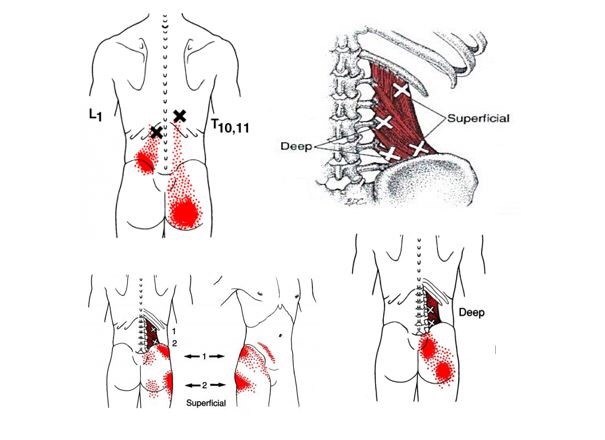
Identifying Key Lower Back Muscles and Their Trigger Points

In your journey to understand and combat low back pain, it’s vital to recognize the specific muscle groups that commonly harbor trigger points. These often overlooked culprits can significantly contribute to discomfort and limited mobility in the lower back region.
Quadratus Lumborum
The quadratus lumborum, often overlooked, plays a crucial role in stabilizing your lower back and aiding in movements such as bending and twisting. This deeply situated muscle connects the pelvis to the spine and lower ribs.
Due to its importance in maintaining posture, it’s not uncommon for trigger points here to cause significant discomfort that radiates through the low back area. By targeting these trigger points through therapy for low back pain, you can achieve substantial relief.
Engaging in targeted exercises and stretches designed for the quadratus lumborum helps maintain a healthy range of motion and reduces discomfort. Techniques like neuromuscular massage therapy can effectively release trigger points within this muscle group, addressing both pain locally around the buttock area and referred pain patterns that spread from these central points.
Managing this muscle’s health is key to alleviating ongoing issues with lower back pain caused by active trigger points.
Spinal Extensors
Spinal extensors play a crucial role in maintaining proper posture and allowing you to stand up straight. These muscles run along your back, from the base of your spine all the way up to your neck.
When trigger points develop in these muscles, they can cause pain that radiates across your back or even down into your hips. It’s important to treat these trigger points because they often contribute to chronic lower back pain.
To tackle the discomfort caused by spinal extensor trigger points, therapists may use techniques such as manual pressure release or myofascial release. Applying sustained pressure helps relax muscle fibers and alleviate pain.
Regular treatment can reduce tightness in the lower back and improve range of motion, helping you feel more comfortable during daily activities. Remember that taking care of your spinal extensors is vital for overall back health and mobility.
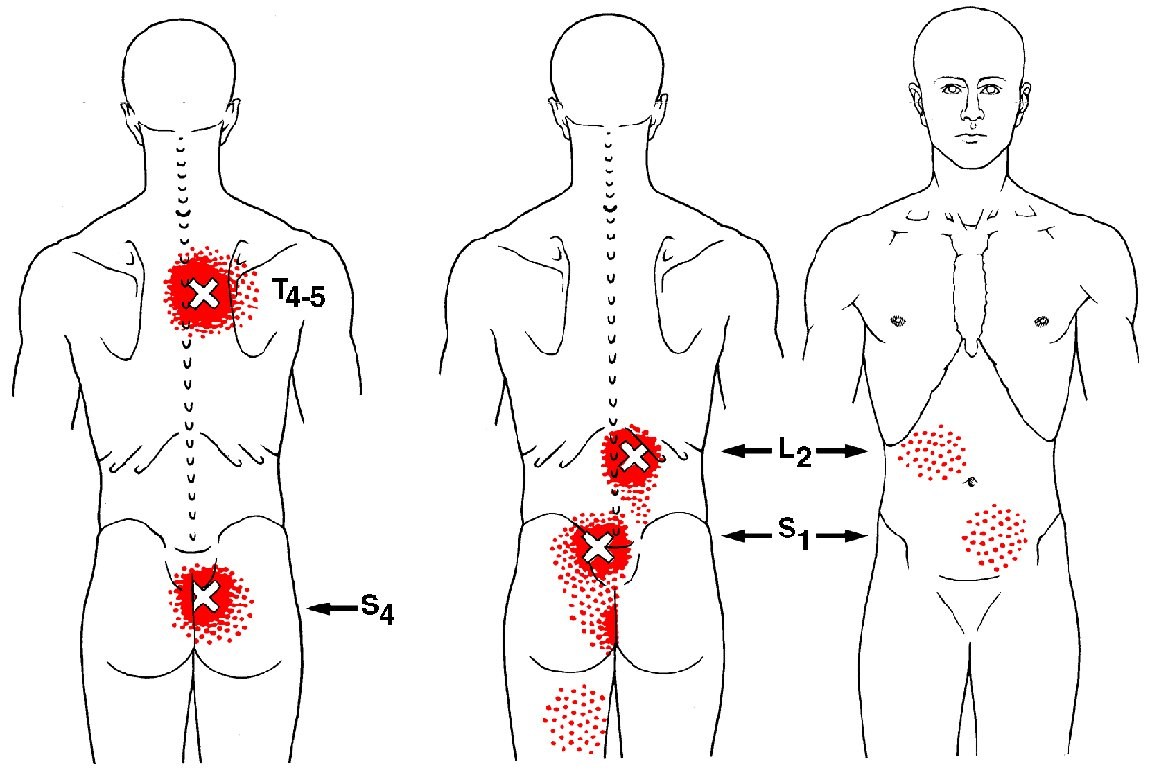
Multifidus
The multifidus muscle plays a crucial role in stabilizing the joints within the spine. Often overlooked, this deep back muscle supports posture and spinal alignment, which is key to preventing low back pain.
If your multifidus isn’t working properly, it can become a source of lower back trigger points that refer pain to surrounding areas.
Effective management of these trigger points involves therapies like neuromuscular massage or targeted exercises designed to strengthen this core muscle. Strengthening and maintaining the health of the multifidus can lead to significant improvements in back function and reduction in discomfort.
Next up, let’s explore some hands-on techniques for achieving relief from those pesky lower back trigger points.
Techniques for Pain Relief from Lower Back Trigger Points
Discover a variety of hands-on techniques and targeted movements designed to address your lower back trigger points, providing the relief necessary for an improved quality of life—explore these methods further to find out how you can alleviate your discomfort.
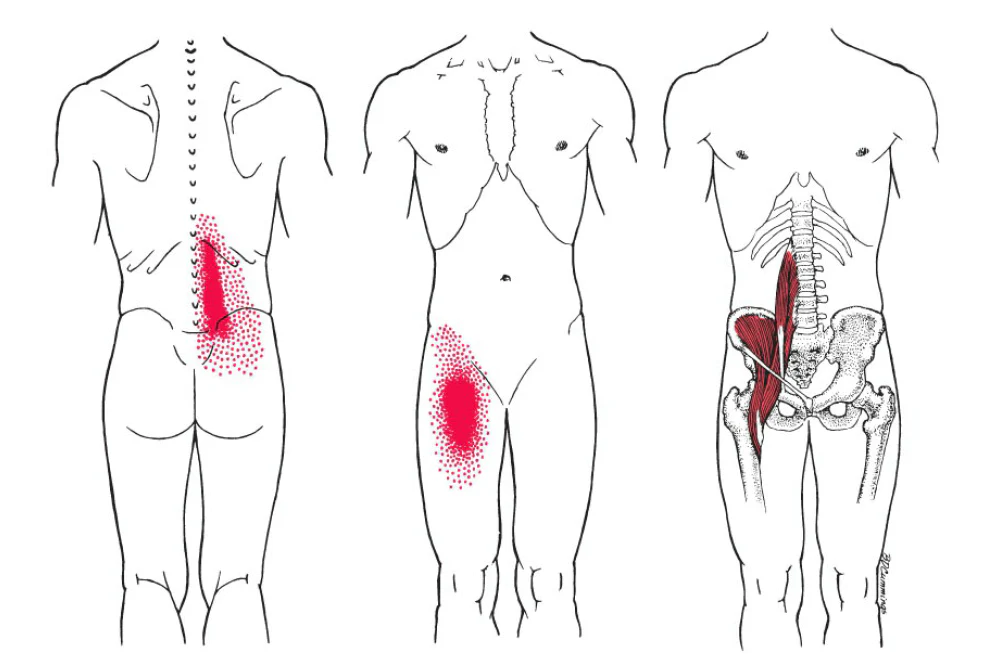
Neuromuscular Massage Therapy
Neuromuscular massage therapy is a specialized form of manual pressure release that targets painful trigger points in your muscles. This technique helps to alleviate the pain and discomfort you may feel in your lower back area.
A trained massage therapist applies specific pressures to these sensitive areas, seeking to reduce pain and improve muscle function. By using methods such as ischemic compression, therapists can identify and deactivate triggers points contributing to low back pain.
During a neuromuscular therapy session, you’ll find the experience goes beyond typical massage techniques. It focuses on releasing contracted muscles, which often refer pain to other parts of your body like the hip or mid-back.
This approach not only works for immediate relief but also aims at tackling underlying problems caused by poor posture habits or chronic muscle tension. Using this therapy can help restore normal movement and provide lasting solutions for those experiencing myofascial-related lower back issues.
Stretching Techniques
Stretching is essential for relieving pain from trigger points in the lower back. It promotes flexibility, increases blood flow, and helps release muscle tightness.
- Gentle Yoga Poses: Engage in yoga positions like Child’s Pose or Cat-Cow stretch to gently work the muscles of the lower back and hips. These movements encourage circulation and can ease muscle tension.
- Pelvic Tilts: Perform pelvic tilts to strengthen your core and stabilize your lower spine. Lie on your back with knees bent and slowly arch your lower back, pressing it into the floor to activate those deep muscles.
- Knee-to-Chest Stretch: While lying down, bring one knee at a time toward your chest. This action stretches the gluteus medius muscle and helps relieve pressure on low back trigger points.
- Hamstring Stretch: Lengthen your hamstring muscles by sitting or standing and reaching forward toward your toes. Keeping these large leg muscles flexible reduces strain on the lower back.
- Piriformis Muscle Stretch: Target the piriformis, a small muscle that can affect sciatic pain when tight, by crossing one ankle over the opposite knee while sitting and leaning forward.
- Hip Flexor Stretch: Counteract extended periods of sitting which can shorten hip flexors leading to low back pain. Lunge forward with one foot while keeping the other leg extended behind you.
- Spinal Twist: Gently twist your torso while seated or lying down to create rotational mobility in the spine. This type of stretching can alleviate trigger point discomfort within spinal extensors.
Targeted Exercises
Targeted exercises play a crucial role in relieving low back pain associated with trigger points. Engaging in specific movements can help alleviate discomfort by working the affected muscles.
- Begin with pelvic tilts to warm up your lower back. Lie on your back with knees bent, flatten your spine against the floor by gently contracting your abdominal muscles, and hold for five seconds before releasing.
- Progress to knee-to-chest stretches which target the gluteus maximus muscle and relieve pressure on sciatica-related trigger points. Pull one knee towards your chest while keeping the other foot flat on the ground, holding for 15-30 seconds.
- Perform the quadratus lumborum stretch by lying on your side and pulling your top knee toward your chest, reaching overhead with your top arm to create a gentle stretch along the side of your torso.
- Strengthen core muscles using the bird – dog exercise; stabilize yourself on all fours and extend one arm forward while stretching the opposite leg back, keeping your spine neutral.
- Try bridges to reinforce spinal extensors: lie on your back with knees bent and feet flat, then lift hips upward, forming a straight line from shoulders to knees.
- Work on iliopsoas muscle flexibility through lunges; step forward with one leg and lower hips until both knees are at 90-degree angles, ensuring you keep upper body straight.
- Use self-massage techniques post-exercise to ease trigger points that cause referred pain; apply consistent pressure using a massage tool or hands to tender spots within lower back muscles for about 30 seconds.
- Incorporate hamstring stretches since tight hamstrings often contribute to lower back issues; place one foot in front of you and bend forward from hips while keeping your back straight.
Symptoms and Diagnosis of Lower Back Trigger Points
Lower back trigger points can sneak up on you, presenting with a dull ache or even sharp pain in your lower back and hips. Often, these painful spots might refer sensations to other areas of your body, tricking you into thinking the problem lies elsewhere.
You may find certain movements exacerbate the discomfort, making daily tasks feel tougher than usual. Frequent signs include muscle stiffness, tenderness at specific points on your lower back, and sometimes even radiating pain down your legs.
Diagnosing these elusive culprits requires a keen understanding of myofascial patterns and often involves physical examination by a healthcare professional trained in trigger point therapy.
Using ischemic compression techniques or applying pressure to suspected areas helps pinpoint the exact locations that are causing trouble. Relief comes when these identified trigger points are treated with methods like manual pressure release or self-massage—bringing much needed comfort to those tight muscular knots within your lower back muscles.
Contraindications of Lower Back Trigger Point Therapy
Lower back trigger point therapy can be an effective treatment for muscle pain, but it is not right for everyone. Certain conditions may prevent you from safely receiving this type of therapy.
– If you are taking blood thinners or have a bleeding disorder, pressure applied during the therapy could cause bruising or more serious complications.
– A recent fracture in your lower back area might worsen with the added pressure and manipulation associated with trigger point release techniques.
– Skin infections or open wounds near the treatment area pose a risk of spreading infection when undergoing manual therapies.
– Severe osteoporosis creates vulnerability to fractures; intense treatments like trigger point therapy could potentially lead to bone injury.
– Patients with advanced diabetes may have a reduced sensation leading to an increased risk of injury from treatments that involve deep tissue work.
– Individuals who have had recent surgery in the lower back region need time to heal before engaging in any form of physical manipulation such as trigger point therapy.
– People experiencing acute flare-ups of low back conditions should avoid this therapy as it could exacerbate pain and inflammation in affected areas.
– Those diagnosed with malignant tumors within their musculoskeletal system must refrain from receiving massage-based treatments on areas close to tumors.
Conclusion
Understanding your lower back’s trigger points empowers you to manage pain more effectively. Techniques like neuromuscular massage therapy, stretching, and targeted exercises offer relief for many suffering from this common discomfort.
With the right approach, pinpointing and treating these nagging spots within the muscle can lead to significant improvements in your daily life. Remember, persistent pain should not be overlooked; professional guidance ensures safe and appropriate treatment of low back issues.
Embrace these strategies as tools for a stronger, more comfortable back.
Here is an example of one my personal NMT protocols for lower back:
Sam Visnic
Most Popular Posts
Categories
- Deep Gluteal Pain Syndrome (8)
- Deltoids (2)
- Foam Rolling (2)
- Glutes (9)
- Hamstrings (5)
- Hypnosis for Pain (3)
- Lats (2)
- Levator Scapulae (4)
- Lifestyle (8)
- Massage Therapy (39)
- Mobility (21)
- Movement and Exercise (19)
- Muscles (22)
- Nutrition (2)
- Obliques (1)
- Pain (25)
- Pectorals (3)
- Piriformis (3)
- Plantar Fasciitis (11)
- Psoas (11)
- Quadratus Lumborum (3)
- Quadriceps (2)
- Rhomboids (3)
- Sciatica (1)
- Serratus Anterior (1)
- SI Joint (14)
- Sternocleidomastoid (1)
- Stretching (18)
- Subscapularis (1)
- TMJ (2)
- Trapezius (1)
- Uncategorized (12)


